Call us to place your order +254 721 510369 | +254 736 325749

We all know the healthy benefits of green tea, but did you know purple tea has greater antioxidant activity than green tea and black tea? Purple tea is a new cultivar of Camellia Sinsensis, containing exceptionally high levels of catechins and epigallocatechin galette (EPCG). These have been linked to reducing body fat and fighting diseases like cancer, heart disease and diabetes.
History
The origin or history of purple leaf tea starts with the first wild mutant plant. It was discovered at the Assam tea gardens of India. It was gifted to the Tea Research Institute, formally known as the Tea Research Foundation of Kenya (TRFK). This was done in hopes that it would be a variety suitable for growing there. The cultivation of it began there in the 1980’s and finally in 2011, the seedlings were made available to small-scale farmers in Kenya.
Officially, the purple tea plant is designated TRFK306 and it’s classified as a green tea, since it’s most often processed in the same manner. The scientific name for the plant species is Camellia sinensis var. assamica. The “assamica” simply means it’s using the Assam cultivar of green tea.
Regular green tea from China is Camellia sinensis var. sinensis. Same species, different cultivar.
Camellia sinensis var. assamica can have normal green leaves, too. It’s only of the TRFK306 variety of it that produces the purple pigments, at least among those commercially sold.
More recently, the Chinese have cultivated similar clones of this original Indian/Kenyan variety. In China, Hanlu and Zijuan tea are the names given for their purple. Japan grows it under the name Yabukita. In total, there are at least 12 version of purple tea being grown throughout the world today. They are all extremely similar when it comes to their genetic profiles and phytonutrients.

The origin or history of purple leaf tea starts with the first wild mutant plant. It was discovered at the Assam tea gardens of India.
What’s so great about the purple tea? It has been found to have a host of medicinal properties, is rich in anthocyanins and contains lower catechins. Purple tea has low caffeine content and is high in antioxidants that provide anti-cancer benefits, improve vision, lowers cholesterol and blood sugar metabolism.
What is Purple Tea?
Purple tea is derived from Camellia Sinensis, the same plant as white, black, and green tea. A genetic mutation in the plants essentially causes the leaves to turn the drink purple. Anthocyanins cause this interesting discoloration. The difference is that it has a natural genetic mutation which causes it to produce purple-colored leaves
That’s the same class of pigments which make blueberries look blue and gives acai its signature magenta color.
Anthocyanins help protect plants from environmental stressors, such as intense sunlight and extreme temperatures.
Purple leaf tea is exposed to extreme growing conditions. It grows on mountains at elevations of 4,500 to 7,000 feet (1,350 to 2,150 meters). The thinner atmosphere up there means less protection from solar rays.
That fact, compounded with most growing ranges being near the equator, means the purple tea plant is exposed to excessive amounts of UV radiation. The anthocyanin pigments help protect them.
It has a similar taste to white tea but with a fruity, raspberry hint.
Purple Tea Benefits
There are several benefits to purple tea, whether it’s for drinking or as an ingredient to skin care products. These benefits make it worth a second glance and another sip or two of the delicious brew. But many people are discovering that while purple tea benefits go well beneath the skin’s surface, some of the benefits truly are skin deep, resulting in younger looking skin and true wrinkle-fighting power.
Some of its astounding health benefits include:
- Anti-Inflammatory and Anti-Viral Properties.
- Antioxidant Properties Galore.
- Improved Cardiovascular Health..
- May Enhance Cognitive Function.
- Assists in the War on Obesity.
- Prevents Diabetes.
- Detoxifies the Liver and Improves Liver Health. …
- Helps to Prevent Hair Loss and Improves Scalp Health.
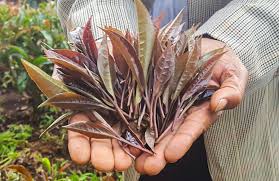
A genetic mutation in the plants essentially causes the leaves to turn the drink purple. Anthocyanins cause this interesting discoloration.
ANTHOCYANINS
Purple tea contains red and purple anthocyanins – antioxidants which produce the distinctive reddish purple colours of the leaves. These are related to similar extra high levels of anthocyanins compounds found in blueberries, raspberries, purple grapes, and other common foods that contribute to their characteristic colors and health benefits. Blueberries are particularly rich in anthocyanins, which have been shown in studies to help fight cancer, cardiovascular disease, and cognitive issues.
But purple tea has a much higher content of anthocyanins than even blueberries—1.5 percent compared to 0.1 percent. Scientists believe the anthocyanins combat free radicals in your body, soothe inflammation, and power tremendous health benefits.
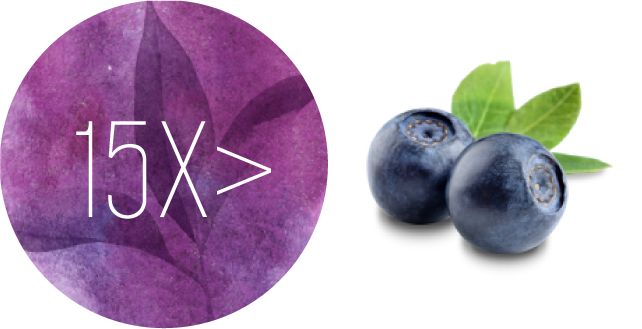
Purple tea contains 15 times more anthocyanins than blueberries
ANTIOXIDANTS
Did you know that many studies, like this one from MayPro, have found that purple tea has a greater degree of antioxidant activity than either green or black tea? Research shows that purple tea has a free-radical scavenging rate of 51% compared with 34.3% for green tea.* And the more free radicals that antioxidants attack in your body, the less likely you are to get chronic diseases!
Purple tea is the supertea! And these tremendous health benefits are by-products of an otherwise delightful tea drink! So let’s raise a glass of tea and drink to your taste and your health.

Purple tea contains 51% antioxidants and Green tea contains only 34.3% antioxidants
POLYPHENOLS
Purple tea contains a unique and more powerful polyphenol than green or black teas (16.5 percent, compared to 10.1 percent for black tea and 9.1 percent for green tea), according to OmniVista Health Learning. Polyphenols are chemicals found in foods that help to prevent the damage of free radicals in the body — unstable molecules that can damage the arteries and cause numerous health problems. Different types of polyphenols exist, and eating a wide variety of foods will ensure you get the healthiest diet possible. Several studies have been conducted in an attempt to learn which foods contribute the highest levels of polyphenols to our bodies.
Purple tea has a unique type of polyphenol called GHG that’s not found in other tea varieties. GHG may be the compound responsible for purple tea’s anti-obesity effects. Scientific research tells us that purple tea helps with weight loss and brain health. An extract of purple tea with GHG has been shown in two human studies to support weight loss. It decreased body mass index, fat mass, hip size, waist size, and subcutaneous-fat thickness while improving body composition and lean body mass.
Some of its astounding health benefits include:
- Anti-Inflammatory and Anti-Viral Properties.
- Antioxidant Properties Galore.
- Improved Cardiovascular Health..
- May Enhance Cognitive Function.
- Assists in the War on Obesity.
- Prevents Diabetes.
- Detoxifies the Liver and Improves Liver Health. …
- Helps to Prevent Hair Loss and Improves Scalp Health.
1. Anti-Inflammatory and Anti-Viral Properties
Thanks to its anti-inflammatory and anti-viral properties, drinking this tea helps you fight off fevers and flu. It can also help ease pain from arthritis and other inflammation in the body.
2. Antioxidant Properties Galore
Purple tea contains more antioxidants than black and green tea, believed to fight several types of cancer, such as breast cancer, prostate cancer, colon cancer, oral cancer, and tumor metastasis.
3. Improved Cardiovascular Health
This Kenyan tea reduces LDL cholesterol while increasing HDL cholesterol (the beneficial variety), thus preventing risks of high blood pressure.
4. May Enhance Cognitive Function.
According to a study by the National Center for Biotechnology Information, the antioxidants found in Kenyan purple tea may boost brain health and function. This means purple tea could be taken in supplement form to reduce the risk of neurodegenerative diseases like Alzheimer’s and dementia.
5. Assists in the War on Obesity
Kenyan purple tea is also an outstanding source of catechins and epigallocatechin galette (EPCG). Both of which help with weight loss, more specifically with fighting off body fat and diseases.
6. Prevents Diabetes
The unique phytochemicals found in purple tea helps control blood sugar. Those with a higher risk of diabetes would benefit from drinking it.
7. Detoxifies the Liver and Improves Liver Health
It improves metabolism of hepatic fat, which helps detoxify the liver. This, in turn, helps the body lose unwanted fat and other dangerous toxins in the body.
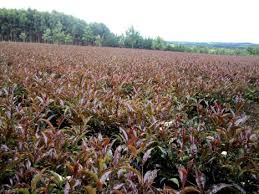

8. Helps to Prevent Hair Loss and Improves Scalp Health :
Daily Nation cites benefits, such as evening out the skin tone, oxygenating the skin, and serving as a tonic to soothe the scalp and aid with the prevention of hair loss. Most people recognize visible results within only a few short weeks of use (typically after two weeks of use) from drinking tea alone. Using skin care products that contain purple tea and its active ingredients can enhance those benefits, offering even faster results.
9. Improves Vision
Delphinidin, the same compound that helps control blood sugar, also contributes to improved eye health. It is suggested that delphinidin offers relief from dry eyes.
10. Almost No Calories
Half a liter of purple tea only has about 10 calories. So you won’t have to worry about it contributing to your daily calorie count.
11. Anti-Aging Properties
The tea is also a popular ingredient in a variety of skincare products that help to fight wrinkles, improve skin tone, enhance complexion, and support overall beauty. While it originated in India, Times of India reports that the rich brew is only available in Kenya, the world’s largest producer of tea after China and India.
12. No Caffeine Jitters
One of the unanticipated benefits of purple tea is its lower caffeine content when compared to not-so-distant relatives like green and black tea. This allows you to drink more of this delicious concoction without experiencing unwanted caffeine jitters as a result.
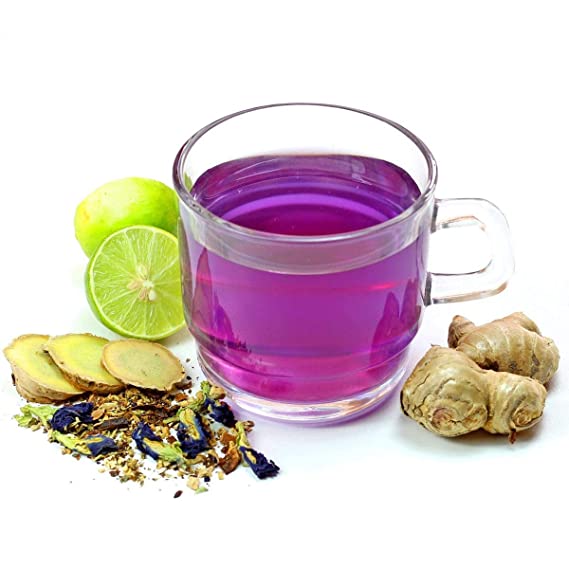
Half a liter of purple tea only has about 10 calories. So you won’t have to worry about it contributing to your daily calorie count.
Why Does Purple Tea with GHG Work for Certain Ailments?
The higher antioxidant levels of Kenyan purple leaf tea are easily related to things like fighting the signs of aging. However, when used for weight loss support, purple tea with GHG is suspected to be an inhibitor of lipase, a bodily enzyme known for breaking down fats during digestion.
Are There Scientific Studies on Purple Tea with GHG?
There are actually a few pertinent studies which have been done on purple tea with GHG. Published by Maypro, a four-week study took a look at skin problems and obesity in 18 volunteers who were otherwise healthy.
Volunteers who participated ingested 100-mg capsules of purple tea with GHG. Prior to the study, all participants were measured by weight, BMI, and the thickness of fat tissue at certain points of the body.
Specific aspects of the skin were also assessed, such as collagen score measurements, oil content, and moisture content. Results after the four-week study showed that female participants had reduced BMI and hip sizes and increased collagen content in the cheeks.
Male participants saw reductions in fat thickness in places like their arms and abdominal area. Additionally, there were positive changes in collagen scores on the face.
A second study performed in 2014 was just as promising. The study was done using actual dried leaves of the purple tea plant that were used to dose male subjects two times every day for a period of 14 days by giving them brewed Purple Tea.
At the end of the two-week study, there was a body fat decrease of as much as 1.76 pounds, LDI cholesterol and triglycerides were lowered, and hip and waist sizes went down by about an inch. There were also positive improvements in things like BMI, muscle and body fat ratios, and fat in the upper parts of the arms.
What does it taste like?
Purple tea tastes and smells like white tea, but with a hint of fruit like raspberry. It’s a completely smooth, mellow, and mild flavor. It doesn’t have the bitterness or astringency one gets with green tea. Nor is there a vegetal or grassy flavor.It even has less astringency than the finest ceremonial grade matcha, which is made with the youngest green tea leaves and partially grown in shade.
Even to children, the amethyst colored tea is considered palatable without sugar or milk. Not a response you’d be likely to get, if you were to give a young boy or girl unsweetened black/green tea for the first time.
Because there’s lower tannin content, side effects of purple tea are less likely when compared to green and black. Stomach ache, nausea, vomiting, and other common reactions are caused by the tannins in tea.
The Japanese Yabukita and Chinese Zijuan are more bitter than the Kenyan and therefore, are more likely to cause side effects in people sensitive to tannins.

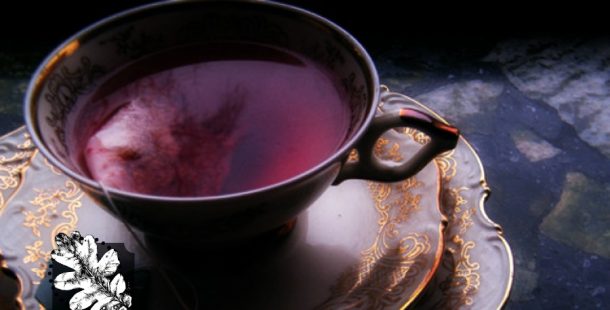
Some relevant bio-chemical characteristics of purple tea
1. More antioxidants than black and green tea
Other tea leaves average 10% or less polyphenol content, while purple tea has measured at 16.5%. That’s according to reports published by the brand Purpose Tea and Maypro, a nutraceutical ingredients company (we reviewed the reports, which are not online).
When it comes to the anthocyanins, the whole leaves have up to 15x higher content than fresh blueberries; 1.5% versus 0.1% by weight.
ORAC values have not been tested but most likely, how much antioxidants there are in purple tea rivals matcha.
2. Stomach-friendly source of caffeine
There are very few natural foods with caffeine. Aside from cocoa and certain species of holly, like yerba mate and guayusa, coffee and tea are the two main dietary sources.
Purple tea comes from the Camellia sinensis plant, just like green and black tea does. For that reason, it is a natural source of caffeine.
The Hanlu purple tea variety has the most caffeine at 2.42% by weight, while others tested are not far behind at 2.21 to 2.33%. They also contain theobromine, which is a neurostimulant similar to caffeine that has energizing, yet relaxing properties. (2)
This amount of caffeine is slightly less than regular green and white tea, so brew the purple stronger if it’s an energy boost you’re after. (3)
Other teas can cause an upset stomach due to high tannin content. Coffee can too, because it’s acidic. Furthermore, many people have an increased urge to defecate after drinking coffee due to a unique amino acid it contains. When you drink purple tea, you get the advantage of caffeine without these adverse reactions.
3. Almost no calories
Unsweetened purple tea has no calories. Technically it has a few, but due to the labeling laws for nutrition facts, most standard serving sizes round down to 0 calories because there are less than 5.
Being a no calorie beverage isn’t unique for tea. What is unique is that unlike green and black, the taste of purple is enjoyable to most even when unsweetened.
The same can’t be said about most commercial varieties for other types of caffeinated teas.

4. Weight loss by altering fat absorption
Kyoto Pharmaceutical University in Japan conducted experiments using the Kenyan purple tea variety (TRFK306).
The first experiment involved mice.
For 17 days, they were placed on a high-fat diet using olive oil. Some received a purple tea dosage equivalent to 200 mg per kg of body weight. The other group did not. Both were compared against a group of mice on a normal diet.
Even though they were consuming the same amount of calories, those getting the PTE had significantly lower body weight than the regular high-fat diet group.
“PTE administration (200 mg/kg) significantly suppressed body weight gain, liver weight, abdominal fat and triglycerides in serum and liver. Protein expression of carnitine palmitoyltransferase (CPT) 1A was also enhanced.”
Next, they did a small clinical trial involving “mildly obese” humans. All had a BMI above 24. There were 10 men total and they ranged from 32 to 69 years old (47.1 on average).
While the scientists obviously couldn’t dissect their bodies and livers like they did the mice, the benefits on human weight loss and fat metabolism appeared to be similar.
After 4 weeks of drinking purple tea daily, participants had lower body weight, BMI, body fat mass, abdominal fat, and waist size. Their muscle ratio went up and no side effects were reported.
The caffeine content is believed to be partially responsible for the weight loss benefit. In addition to EGCG and ECG, which are found in green tea and believed to be contributors, the purple leaf contains 6.2 to 8.4% GHG. That’s short for hexahydroxydiphenoyl-ß-D-glucose.
GHG is unique to purple tea and scientists report that it alters the way the liver metabolizes lipds (fats) by enhancing CPT1A gene expression.
This is why purple might be better than green tea for weight loss. (4)
5. Potent source of delphinidin
Anthocyanins are not a single compound. They’re a large category of plant pigments which produce most blues and purples, as well as many reds, in the vegetables and fruits you eat.
One type in particular which is getting a lot of buzz are what’s called delphinidin anthocyanins.
Specifically, it’s 3-sambubioside-5-glucoside.
While acai is rich in anthocyanins, it has a poor concentration of this type.
What does have a high amount is maqui berry and this tea.
In fact, for the Ziyan tea cultivar out of China, it tests as having 70.76 mg per 100g of dry leaf. This is an extremely high concentration. (5)
There’s not human and animal researched focused on the tea, but research using isolated delphinidin anthocyanins (from other sources) has suggested they may offer relief for dry eyes and help diabetics with blood sugar control.
In this chart, you can see how in a dose-dependent manner, intake of Delphinol (a patented extract) correlated with lower blood sugar in a human clinical trial. (6) (7)
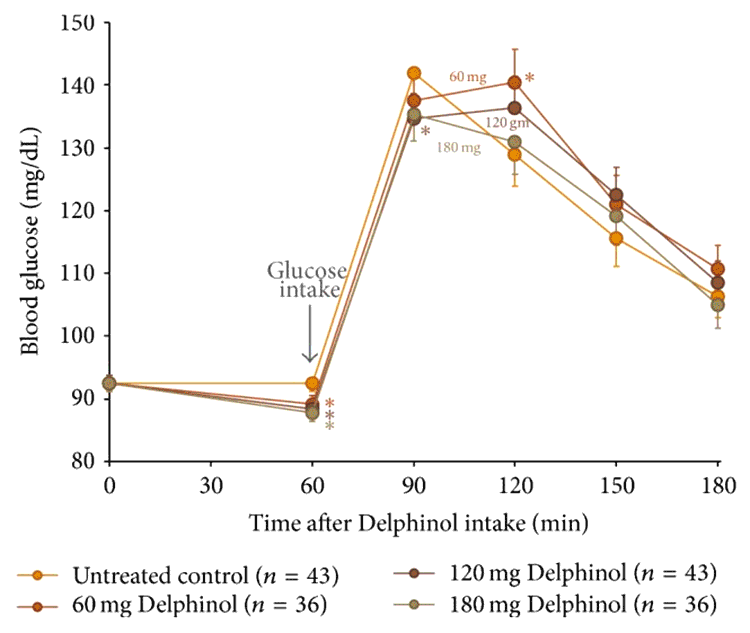
6. Anti-cancer activity in lab research
In 2017, a university in India reported that several anthocyanins extracted from purple teas showed “promising apoptosis induction activity” in cultured rat brain cancer cells.
Apoptosis is the normal death of cells, a process which cancer is notorious for evading.
They also reported immune system stimulation potential. (8)
Another study from 2017, this one from a Kenyan university, did experiments using metastatic breast cancer model using a mouse cell line.
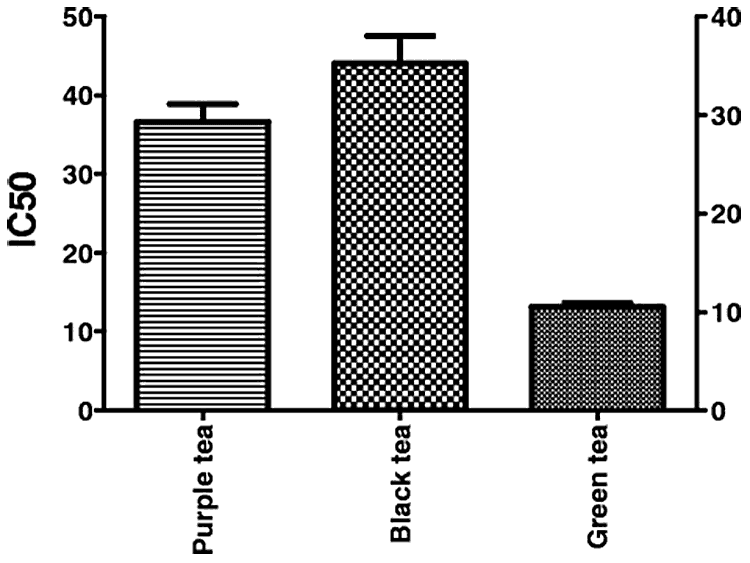
The anti-cancer activity of the purple was over double that of green tea, though surprisingly, it was black which did best in this experiment. (9)
At a university in Taiwan, extracts of purple-shoot tea (what they call it) was tested in the lab against cultured human colon cancer cells in 2014. They said the results showed that it is “a potential novel dietary agent for colorectal cancer chemoprevention” because it inhibited proliferation through multiple pathways. (10)
7. May support brain health
Mice have a blood-brain barrier (BBB) that is similar to humans. Researchers have confirmed that the anthocyanins in Kenyan purple tea cross this barrier and reinforce antioxidant activity in their brain. This benefit was amplified when CoQ10 was given along with them. The research suggested it might offer advantages for neurodegenerative diseases, like Alzheimer’s and dementia.
While not proof for humans, this study does suggest that the tea leaf offers a source of antioxidants that probably can cross into our brain. That’s not something you can say about all dietary antioxidants, because of the blood-brain barrier which filters out many compounds from entering.
IF YOU WISH TO ACCESS MORE INFORMATION ABOUT ORGANIC KENYAN PURPLE TEA, TUNE TO:
Disclaimer
This content is strictly the opinion of its author and is meant for informational and educational purposes only. It is not intended to provide medical advice or to take the place of medical advice , diagnosis or treatment from a personal physician.
Readers of this content are advised to consult their doctors or qualified health professionals regarding specific health questions. Neither the author nor publisher of this content takes responsibility for possible health consequences of any person or persons reading or following the information in this educational content.
All readers of this content, especially those taking prescription or over-the-counter medications, should consult their physicians before beginning any nutrition or supplement or lifestyle programme.



